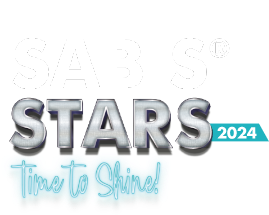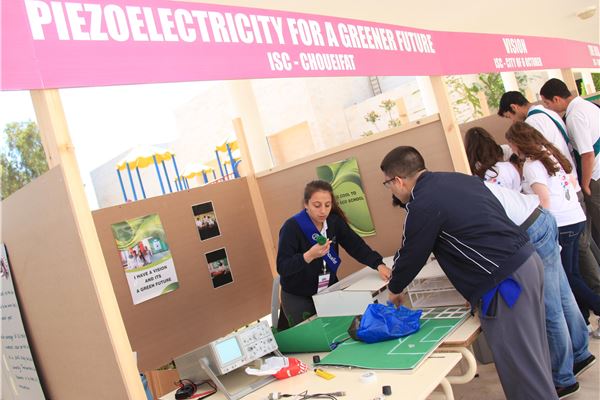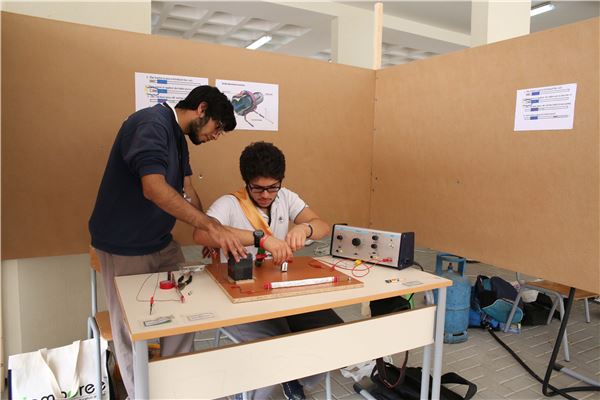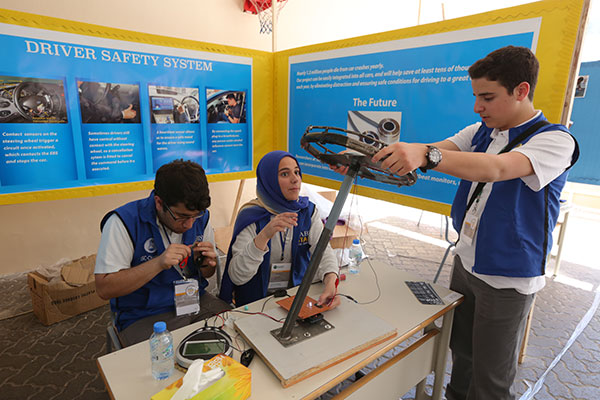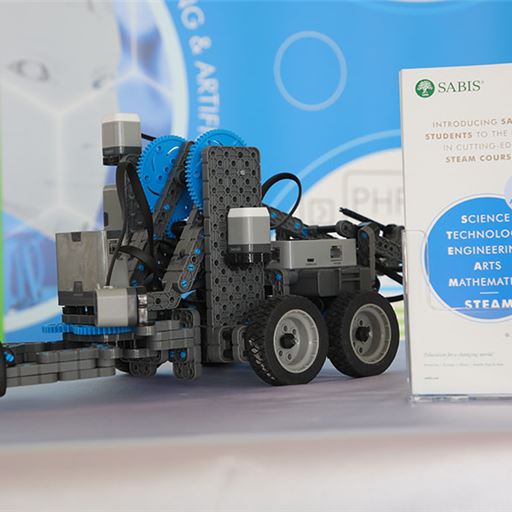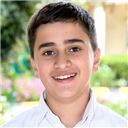WINNERS - Senior
| School | Country |
|---|---|
| AIS-Al-Sulaimaniah | K.S.A. |
WINNERS - Junior
| School | Country |
|---|---|
| ISC-Sharjah | U.A.E. |
FINALISTS - Senior
| School | Country |
|---|---|
| AIS-Al-Sulaimaniah | K.S.A. |
| ISC-Ajman | U.A.E. |
| SIS-Adma | Lebanon |
FINALISTS - Junior
| School | Country |
|---|---|
| ISC-Sharjah | U.A.E. |
| SABIS®ULINK | China |
| ISC-Choueifat | Lebanon |
Science fair
Media Gallery
Media Gallery
Media Gallery
Competition Guidelines:
| Participation | Levels |
|---|---|
| I,J,K,L,M,N & O |
Competition Guidelines:
Selection of Educational Projects
Contestants are free to select a project of their choice from a variety of disciplines, such as Computer Science, Chemistry, Physics, Space, Engineering, Electronics, Biology, or any other subjects.
Requirements for participation:
Contestants participating are required to complete the set-up and decorate the stall before the start of the exhibition schedule. The contestants shall exhibit their projects by:
- Using a display poster board (the internal walls of the stall). While planning and preparing your display board please remember that people will tend to "read" it like they do with books in English (from left to right and top to bottom). Therefore, and as a general guidance, let your display board follow the same pattern.
With the title being the only exception it should be located at the top center of your display. The order of display material would be:- Title: The title of your project.
- Problem / Purpose: State the problem that you were originally concerned with and explain why you selected the topic you did?
- Hypothesis: State your hypothesis
- Procedures: State the procedures you followed. What experiments did you perform and why?
- Results: Display and explain the results.
- Display your results preferably as Data, Graphics, Pictures, etc. Remember that few visuals are worth thousands of words.
- Interpret and explain your results
- Conclusions: Was your hypothesis right or wrong? You might want to add a new statement based on your work and findings?
- Recommendations: From everything you learned would you make any recommendations for further research? Write your ideas for research in this section.
Check below for general guidance:

- Verbal presentation (5 to 10 Minutes) followed by a Q&A: The presentation would be a run through the material displayed in the stall in the order of display presented in the section above.
- Using a functional/illustrative model (Optional) (should fit within the stall space).
- Live Demos are encouraged provided it can be performed inside the stall/dedicated area. Otherwise, recorded demos would suffice. Display devices must be provided by the visiting team.
N.B.: All contestants are expected to bring with them and take back all the exhibition material they need. Any material remaining at the host school will be disposed of.
Exhibition Stalls
The event organizing committee at the host school will set up the following facility for the use of participating teams at the exhibition venue:
- An exhibition stall, size: 2.4m x 2.4m x 1.2m (dimensions may vary slightly).
- A table and 2 chairs placed inside the stall.
- An electric power supply outlet.
- A Fascia indicating the stall number and the project title.
N.B.1: Stalls may be installed in a closed/sheltered area. Contestants must consider this when planning their live demos.
N.B.2: Other than the above listed any other material needed must be provided by the competing team.
Pre-exhibition Deliverables:
A science fair project typically must have the following components.
- Proposal: (for internal school competitions) This is a very brief description of the planned experiment. A short paragraph that should help the school coordinator get a very clear idea of what is going to be done. This should be done very early. It allows the teacher to check that the planned project/experiment is safe, follows legal and ethical rules, and is not a simple demonstration.
- Title: This is the name of the project/experiment. It is a good idea to use your science question as the title for your project.
- Purpose: This is a statement describing what could be learned from doing the project/experiment. Contestants often include ideas about why the project/experiment is important and how the learned information could benefit others.
- Hypothesis: This is a prediction of what's expected to happen in the experiment. This prediction must be based on some research, prior knowledge, or observations. It should be stated in an “If/Then” format. “If _____ [I do this - independent variable] _____, then _____ [this - dependent variable] _____ will happen."
- Materials List: All the equipment and resources needed to do the project/experiment.
- Procedures: This is a step-by-step set of instructions for the project/experiment. It must be very detailed and include accurate measurements of materials needed for each step.
- Results: What was observed at the different stages of the experiment/project?
- Bibliography and References
Judging Criteria
- A panel of Judges will visit the stalls during the exhibition to evaluate the performance of the participating teams and their projects based on below Parameters:
- Scientific approach as demonstrated in the pre-exhibition deliverables (30%)
- Stall presentation (10%)
- Verbal presentation/demonstration + Q&A (30%)
- Benefits & Functionality (30%)
Media Gallery
-
"The feeling when I won was, without a doubt, indescribable. When everybody was cheering me on, I realized that I have accomplished something for myself, but..."Sanad Al Khatib: ISC-Amman Spelling Bee Team / Winner 2014
-
 "SABIS® STARS was a marvelous experience. Not only was it a highly competitive event, but we also had the chance to connect with other students from many..."Daniela Amura: ISC-Amman Debate Team 2014
"SABIS® STARS was a marvelous experience. Not only was it a highly competitive event, but we also had the chance to connect with other students from many..."Daniela Amura: ISC-Amman Debate Team 2014 -
 "SABIS® Stars 2014 was a truly fantastic experience. I got to test my skills against the very best around the region. Representing ISC Koura at such a high..."Habib Saad
"SABIS® Stars 2014 was a truly fantastic experience. I got to test my skills against the very best around the region. Representing ISC Koura at such a high..."Habib Saad -
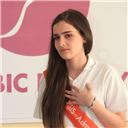 "SABIS® STARS was the highlight of my year. I enjoyed the company of amazing people and got to meet many new friends. I spent my time with people who share..."Diana Ikhwan, Arabic Poetry
"SABIS® STARS was the highlight of my year. I enjoyed the company of amazing people and got to meet many new friends. I spent my time with people who share..."Diana Ikhwan, Arabic Poetry
